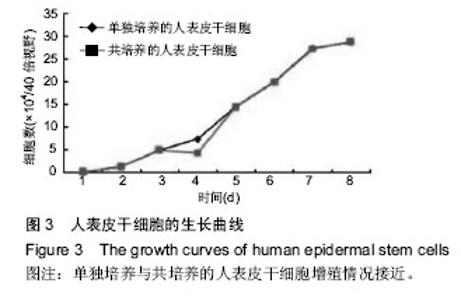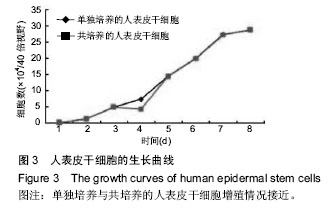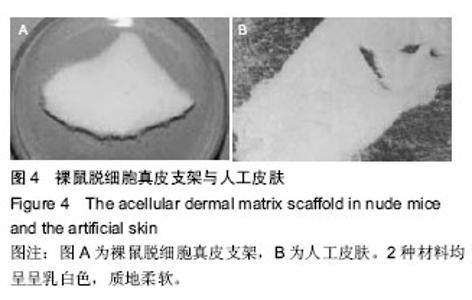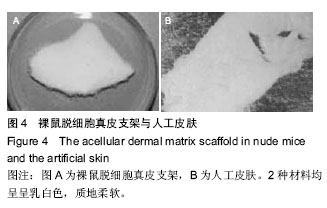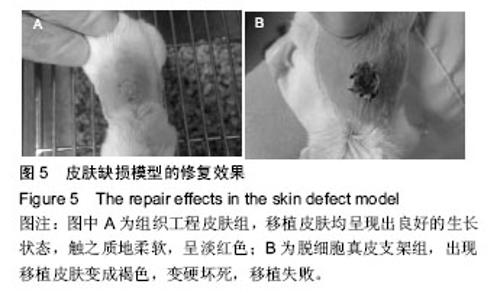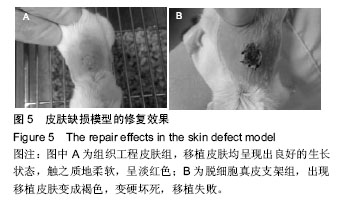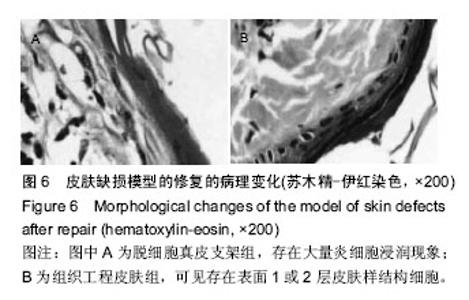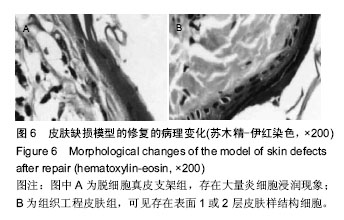Chinese Journal of Tissue Engineering Research ›› 2016, Vol. 20 ›› Issue (25): 3771-3777.doi: 10.3969/j.issn.2095-4344.2016.25.019
Previous Articles Next Articles
Human epidermal stem cells combined with acellular dermal scaffold in nude mice for skin transplantation
Zhao Yue-hua1, Zhang Yong-hong2, Lin Kai3
- 1Department of Dermatology, the Second Affiliated Hospital of Luohe Medical College, Luohe 462300, Henan Province, China; 2Department of Dermatology, Affiliated Zhengzhou Central Hospital of Zhengzhou University, Zhengzhou 450007, Henan Province, China; 3Experimental Animal Center of Henan, Zhengzhou 450000, Henan Province, China
-
Received:2016-04-21Online:2016-06-17Published:2016-06-17 -
About author:Zhao Yue-hua, Associate chief physician, Associate professor, Department of Dermatology, the Second Affiliated Hospital of Luohe Medical College, Luohe 462300, Henan Province, China -
Supported by:the Medical Science and Technology Research Project in Henan Province, No. 201402103
CLC Number:
Cite this article
Zhao Yue-hua, Zhang Yong-hong, Lin Kai. Human epidermal stem cells combined with acellular dermal scaffold in nude mice for skin transplantation[J]. Chinese Journal of Tissue Engineering Research, 2016, 20(25): 3771-3777.
share this article
| [1] 彭燕,彭青,蔡爱英,等.表皮干细胞联合脱细胞真皮构建人工皮肤促进创面愈合的实验研究[C]//中华医学会烧伤外科学分会2009年学术年会论文集,2009:156.[2] 杨斌,丘日升,洪清琦,等.荷载角质细胞生长因子纳米微囊组织工程皮肤修复裸鼠皮肤缺损[J].中华整形外科杂志, 2009,25(3):200-204.[3] Wong MM, Winkler B, Karamariti E, et al. Sirolimus stimulates vascular stem/progenitor cell migration and differentiation into smooth muscle cells via epidermal growth factor receptor/extracellular signal-regulated kinase/β-catenin signaling pathway. Arterioscler Thromb Vasc Biol. 2013;33(10):2397-2406.[4] Rodrigues M, Blair H, Stockdale L, et al. Surface tethered epidermal growth factor protects proliferating and differentiating multipotential stromal cells from FasL-induced apoptosis. Stem Cells. 2013;31(1):104-116.[5] Guturi KK, Mandal T, Chatterjee A, et al. Mechanism of β-catenin-mediated transcriptional regulation of epidermal growth factor receptor expression in glycogen synthase kinase 3 β-inactivated prostate cancer cells. J Biol Chem. 2012;287(22):18287-18296.[6] Szabo AZ, Fong S, Yue L, et al. The CD44+ ALDH+ population of human keratinocytes is enriched for epidermal stem cells with long-term repopulating ability. Stem Cells. 2013;31(4):786-799.[7] Dong R, Liu X, Liu Y, et al. Enrichment of epidermal stem cells by rapid adherence and analysis of the reciprocal interaction of epidermal stem cells with neighboring cells using an organotypic system. Cell Biol Int. 2007;31(7):733-740.[8] Schappa JT, Frantz AM, Gorden BH, et al. Hemangiosarcoma and its cancer stem cell subpopulation are effectively killed by a toxin targeted through epidermal growth factor and urokinase receptors. Int J Cancer. 2013;133(8):1936-1944.[9] 廖立新,陈刚泉,李国辉,等.应用表皮干细胞构建组织工程皮肤及移植实验研究[C]//2006年全国中西医结合医学美容学术研讨会论文汇编,2006:117-124.[10] 彭燕,刘德伍,彭青,等.白细胞介素-10和肿瘤坏死因子-α在组织工程皮肤移植中的表达[C]//2010年第七届全国烧伤救治专题研讨会论文集,2010:191-192.[11] Zhao Z, Zhang C, Fu X, et al. Differentiated epidermal cells regain the ability to regenerate a skin equivalent by increasing the level of β-catenin in the cells. Cells Tissues Organs. 2012;196(4):353-361.[12] Jones PH, Watt FM. Separation of human epidermal stem cells from transit amplifying cells on the basis of differences in integrin function and expression. Cell. 1993;73(4):713-724.[13] Imbert I, Botto JM, Labarrade F, et al. The epidermal basal cellular environment and the proteins of the chromosomal passenger complex are together involved in the homeostasis and protection of the somatic stem cells of the epidermis. J Cosmet Sci. 2011;62(3):346-347.[14] Peng LH, Wei W, Qi XT, et al. Epidermal stem cells manipulated by pDNA-VEGF165/CYD-PEI nanoparticles loaded gelatin/β-TCP matrix as a therapeutic agent and gene delivery vehicle for wound healing. Mol Pharm. 2013;10(8):3090-3102.[15] Fujita Y, Abe R, Inokuma D, et al. Bone marrow transplantation restores epidermal basement membrane protein expression and rescues epidermolysis bullosa model mice. Proc Natl Acad Sci U S A. 2010;107(32):14345-14350.[16] 彭燕,刘德伍,杨慧,等.表皮干细胞联合脱细胞真皮构建人工皮肤促进创面愈合的实验研究[J].实用临床医学, 2009,10(5):1-3.[17] Hartmann-Fritsch F, Hosper N, Luginbühl J, et al. Human amniotic fluid derived cells can competently substitute dermal fibroblasts in a tissue-engineered dermo-epidermal skin analog. Pediatr Surg Int. 2013; 29(1):61-69.[18] Nakaji-Hirabayashi T, Kato K, Iwata H. Essential role of structural integrity and firm attachment of surface-anchored epidermal growth factor in adherent culture of neural stem cells. Biomaterials. 2008;29(33): 4403-4408.[19] Selekman JA, Grundl NJ, Kolz JM, et al. Efficient generation of functional epithelial and epidermal cells from human pluripotent stem cells under defined conditions. Tissue Eng Part C Methods. 2013;19(12):949-960.[20] Krishnamoorthy M, Heimburg-Molinaro J, Bargo AM, et al. Heparin binding epidermal growth factor-like growth factor and PD169316 prevent apoptosis in mouse embryonic stem cells. J Biochem. 2009;145(2): 177-184.[21] Qi SH, Liu P, Xie JL, et al. Experimental study on repairing of nude mice skin defects with composite skin consisting of xenogeneic dermis and epidermal stem cells and hair follicle dermal papilla cells. Burns. 2008; 34(3):385-392.[22] 林尊文,刘德伍,毛远桂.应用表皮干细胞、间充质干细胞构建复合皮肤及移植实验[C]//中华医学会烧伤外科学分会2009年学术年会论文集.2009:8-9.[23] 孙薇,姚志慧,詹日兴,等.P311在小鼠浅Ⅱ度烧伤及体外细胞创伤模型中对表皮干细胞迁移的影响[J].中华烧伤杂志,2012,28(3):213-218.[24] 仇佩庆,王振君,潘孙峰.浅谈表皮干细胞传代于脱细胞真皮基质所形成的复合皮的体会[J].中华损伤与修复杂志(电子版),2009,4(6):44-45.[25] El-Hadidy MR, El-Hadidy AR, Bhaa A, et al. Role of epidermal stem cells in repair of partial-thickness burn injury after using Moist Exposed Burn Ointment (MEBO(®)) histological and immunohistochemical study. Tissue Cell. 2014;46(2):144-151.[26] Peng LH, Mao ZY, Qi XT, et al. Transplantation of bone-marrow-derived mesenchymal and epidermal stem cells contribute to wound healing with different regenerative features. Cell Tissue Res. 2013;352(3): 573-583.[27] De Craene B, Denecker G, Vermassen P, et al. Epidermal Snail expression drives skin cancer initiation and progression through enhanced cytoprotection, epidermal stem/progenitor cell expansion and enhanced metastatic potential. Cell Death Differ. 2014;21(2):310-320.[28] Yang J, Watkins D, Chen CL, et al. Heparin-binding epidermal growth factor-like growth factor and mesenchymal stem cells act synergistically to prevent experimental necrotizing enterocolitis. J Am Coll Surg. 2012;215(4):534-545.[29] El-Assal ON, Besner GE. Heparin-binding epidermal growth factor-like growth factor and intestinal ischemia-reperfusion injury. Semin Pediatr Surg. 2004;13(1):2-10. [30] van der Horst G, Bos L, van der Pluijm G. Epithelial plasticity, cancer stem cells, and the tumor-supportive stroma in bladder carcinoma. Mol Cancer Res. 2012; 10(8):995-1009.[31] Mimeault M, Batra SK. Molecular biomarkers of cancer stem/progenitor cells associated with progression, metastases, and treatment resistance of aggressive cancers. Cancer Epidemiol Biomarkers Prev. 2014; 23(2):234-254.[32] Hennings H, Glick AB, Greenhalgh DA, et al. Critical aspects of initiation, promotion, and progression in multistage epidermal carcinogenesis. Proc Soc Exp Biol Med. 1993;202(1):1-8.[33] Nair RR, Warner BB, Warner BW. Role of epidermal growth factor and other growth factors in the prevention of necrotizing enterocolitis. Semin Perinatol. 2008;32(2):107-113.[34] Scaringi R, Piccoli M, Papini N, et al. NEU3 sialidase is activated under hypoxia and protects skeletal muscle cells from apoptosis through the activation of the epidermal growth factor receptor signaling pathway and the hypoxia-inducible factor (HIF)-1α. J Biol Chem. 2013;288(5):3153-3162. [35] Fan X, Heijnen CJ, van der Kooij MA, et al. The role and regulation of hypoxia-inducible factor-1alpha expression in brain development and neonatal hypoxic-ischemic brain injury. Brain Res Rev. 2009; 62(1):99-108.[36] Wouters A, Boeckx C, Vermorken JB, et al. The intriguing interplay between therapies targeting the epidermal growth factor receptor, the hypoxic microenvironment and hypoxia-inducible factors. Curr Pharm Des. 2013;19(5):907-917.[37] 霍艳丽,张辉.脱细胞羊膜与小肠黏膜下层对大鼠皮肤缺损修复中表皮干细胞的影响[J].河北北方学院学报(自然科学版),2011,27(2):76-79.[38] 刘德伍,熊宏兰,毛远桂,等.表皮干细胞复合脱细胞羊膜构建组织工程皮肤修复深度烧伤创面[C]//2010年第七届全国烧伤救治专题研讨会论文集.2010:186-187. |
| [1] | Zhang Tongtong, Wang Zhonghua, Wen Jie, Song Yuxin, Liu Lin. Application of three-dimensional printing model in surgical resection and reconstruction of cervical tumor [J]. Chinese Journal of Tissue Engineering Research, 2021, 25(9): 1335-1339. |
| [2] | Zeng Yanhua, Hao Yanlei. In vitro culture and purification of Schwann cells: a systematic review [J]. Chinese Journal of Tissue Engineering Research, 2021, 25(7): 1135-1141. |
| [3] | Xu Dongzi, Zhang Ting, Ouyang Zhaolian. The global competitive situation of cardiac tissue engineering based on patent analysis [J]. Chinese Journal of Tissue Engineering Research, 2021, 25(5): 807-812. |
| [4] | Wu Zijian, Hu Zhaoduan, Xie Youqiong, Wang Feng, Li Jia, Li Bocun, Cai Guowei, Peng Rui. Three-dimensional printing technology and bone tissue engineering research: literature metrology and visual analysis of research hotspots [J]. Chinese Journal of Tissue Engineering Research, 2021, 25(4): 564-569. |
| [5] | Chang Wenliao, Zhao Jie, Sun Xiaoliang, Wang Kun, Wu Guofeng, Zhou Jian, Li Shuxiang, Sun Han. Material selection, theoretical design and biomimetic function of artificial periosteum [J]. Chinese Journal of Tissue Engineering Research, 2021, 25(4): 600-606. |
| [6] | Liu Fei, Cui Yutao, Liu He. Advantages and problems of local antibiotic delivery system in the treatment of osteomyelitis [J]. Chinese Journal of Tissue Engineering Research, 2021, 25(4): 614-620. |
| [7] | Li Xiaozhuang, Duan Hao, Wang Weizhou, Tang Zhihong, Wang Yanghao, He Fei. Application of bone tissue engineering materials in the treatment of bone defect diseases in vivo [J]. Chinese Journal of Tissue Engineering Research, 2021, 25(4): 626-631. |
| [8] | Zhang Zhenkun, Li Zhe, Li Ya, Wang Yingying, Wang Yaping, Zhou Xinkui, Ma Shanshan, Guan Fangxia. Application of alginate based hydrogels/dressings in wound healing: sustained, dynamic and sequential release [J]. Chinese Journal of Tissue Engineering Research, 2021, 25(4): 638-643. |
| [9] | Chen Jiana, Qiu Yanling, Nie Minhai, Liu Xuqian. Tissue engineering scaffolds in repairing oral and maxillofacial soft tissue defects [J]. Chinese Journal of Tissue Engineering Research, 2021, 25(4): 644-650. |
| [10] | Xing Hao, Zhang Yonghong, Wang Dong. Advantages and disadvantages of repairing large-segment bone defect [J]. Chinese Journal of Tissue Engineering Research, 2021, 25(3): 426-430. |
| [11] | Chen Siqi, Xian Debin, Xu Rongsheng, Qin Zhongjie, Zhang Lei, Xia Delin. Effects of bone marrow mesenchymal stem cells and human umbilical vein endothelial cells combined with hydroxyapatite-tricalcium phosphate scaffolds on early angiogenesis in skull defect repair in rats [J]. Chinese Journal of Tissue Engineering Research, 2021, 25(22): 3458-3465. |
| [12] | Wang Hao, Chen Mingxue, Li Junkang, Luo Xujiang, Peng Liqing, Li Huo, Huang Bo, Tian Guangzhao, Liu Shuyun, Sui Xiang, Huang Jingxiang, Guo Quanyi, Lu Xiaobo. Decellularized porcine skin matrix for tissue-engineered meniscus scaffold [J]. Chinese Journal of Tissue Engineering Research, 2021, 25(22): 3473-3478. |
| [13] | Mo Jianling, He Shaoru, Feng Bowen, Jian Minqiao, Zhang Xiaohui, Liu Caisheng, Liang Yijing, Liu Yumei, Chen Liang, Zhou Haiyu, Liu Yanhui. Forming prevascularized cell sheets and the expression of angiogenesis-related factors [J]. Chinese Journal of Tissue Engineering Research, 2021, 25(22): 3479-3486. |
| [14] | Liu Chang, Li Datong, Liu Yuan, Kong Lingbo, Guo Rui, Yang Lixue, Hao Dingjun, He Baorong. Poor efficacy after vertebral augmentation surgery of acute symptomatic thoracolumbar osteoporotic compression fracture: relationship with bone cement, bone mineral density, and adjacent fractures [J]. Chinese Journal of Tissue Engineering Research, 2021, 25(22): 3510-3516. |
| [15] | Liu Liyong, Zhou Lei. Research and development status and development trend of hydrogel in tissue engineering based on patent information [J]. Chinese Journal of Tissue Engineering Research, 2021, 25(22): 3527-3533. |
| Viewed | ||||||
|
Full text |
|
|||||
|
Abstract |
|
|||||


